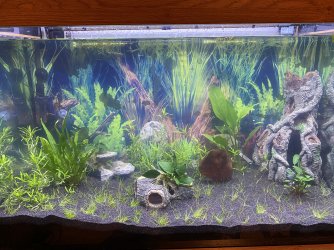Nothing is as beneficial as water changes, and the more the better. But most accept once weekly at 50-70% will remove that amount of "pollution," and there is no other way to remove this crud. Filters do not, plants cannot. Only a substantial water change. I just finished my water changes a few minutes ago, and all three tanks were drained down to about 3-4 inches from the sand. I probably easily changed 80%. I've been doing this for over 25 years now, and my wild caught fish spawn regularly, and more importantly, generally live to or past the average expected lifespan. Providing the right environment (water parameters, aquascape, sufficient numbers of shoaling species, and compatible species) is essential for success. There is no other certainty of healthy fish.
Water stability depends upon significant water changes, along with having a balanced biological system to begin with (meaning the fish species and numbers, not excess feeding, live plants factor in too).



